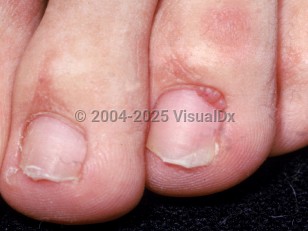Periungual fibroma - Nail and Distal Digit
Alerts and Notices
Important News & Links
Synopsis

Periungual fibromas are small, soft, and compressible papules typically found adjacent to the proximal or lateral nail folds; in the context of tuberous sclerosis (TSC), they are also called Koenen tumors. They are rarely seen in the general population (more commonly isolated, likely due to trauma) and are seen in 15%-80% of patients with TSC (second-hit mutation allelic deletion of TSC2).
Onset of periungual fibromas is typically in the second decade and as late as the fifth decade of life. Periungual fibromas are rarely reported in children younger than 5 years. No differences between sexes or among different ethnicities or races have been reported. Periungual fibromas are occasionally painful, and some are precipitated by trauma. They are more common on the toes than fingers.
Nontraumatic periungual fibromas are a major diagnostic criterion for the diagnosis of TSC. However, patients with a preceding history of trauma should also be examined for manifestations of TSC. In TSC, periungual fibromas are usually the last skin finding to present and subungual fibromas are a further, less frequent finding. "Red comets" (erythronychia) and longitudinal grooves may be found in the nails of patients with TSC, and these findings should increase clinical suspicion of TSC, even in the absence of periungual fibromas.
There is one case report of a periungual fibroma in a patient with Birt-Hogg-Dubé syndrome.
Onset of periungual fibromas is typically in the second decade and as late as the fifth decade of life. Periungual fibromas are rarely reported in children younger than 5 years. No differences between sexes or among different ethnicities or races have been reported. Periungual fibromas are occasionally painful, and some are precipitated by trauma. They are more common on the toes than fingers.
Nontraumatic periungual fibromas are a major diagnostic criterion for the diagnosis of TSC. However, patients with a preceding history of trauma should also be examined for manifestations of TSC. In TSC, periungual fibromas are usually the last skin finding to present and subungual fibromas are a further, less frequent finding. "Red comets" (erythronychia) and longitudinal grooves may be found in the nails of patients with TSC, and these findings should increase clinical suspicion of TSC, even in the absence of periungual fibromas.
There is one case report of a periungual fibroma in a patient with Birt-Hogg-Dubé syndrome.
Codes
ICD10CM:
D21.9 – Benign neoplasm of connective and other soft tissue, site unspecified
SNOMEDCT:
264561009 – Periungual fibroma
D21.9 – Benign neoplasm of connective and other soft tissue, site unspecified
SNOMEDCT:
264561009 – Periungual fibroma
Look For
Subscription Required
Diagnostic Pearls
Subscription Required
Differential Diagnosis & Pitfalls

To perform a comparison, select diagnoses from the classic differential
Subscription Required
Best Tests
Subscription Required
Management Pearls
Subscription Required
Therapy
Subscription Required
References
Subscription Required
Last Reviewed:02/04/2019
Last Updated:12/06/2021
Last Updated:12/06/2021
Periungual fibroma - Nail and Distal Digit

